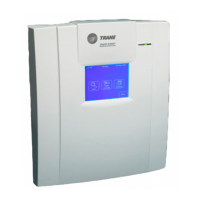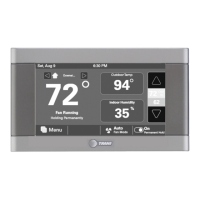Ethernet communication
BMTX-SVN01C-EN 91
Wiring specifications
The Ethernet port on the BMTX BCU supports only twisted-pair wire
(10BaseT or 100BaseT) with RJ45 connectors. With twisted-pair wiring,
one pair is used to receive data signals and the other pair is used to trans-
mit data signals.
If a direct connection between two devices is required, use a crossover
cable. If multiple devices are required to communicate, use straight-
through cable with a multiport hub.
The EIA/TIA cabling standard recommends a maximum segment length
of 295 ft (90 m) between the wire termination equipment in the wiring
closet and the wall plate in the office. This provides 33 ft (10 m) of cable
allowance to accommodate patch cables at each end of the link and signal
losses in intermediate wire terminations on the link.
IMPORTANT
Due to the high precision required when performing twisted-pair wire
terminations, Trane recommends that only qualified technicians with
the proper equipment handle all terminations and splicing.
Table 26 gives twisted-pair wiring distance limitations.
Coaxial cable (10Base2) is not supported by the BMTX BCU. However, an
Ethernet media converter (Allied Telesyn AT-MC15, available from Trane
Buying Group suppliers)
can be used to link existing Ethernet networks
using 10Base2 to Ethernet networks that use 10BaseT.
Trane recommends Cat5, 5e, or 6 cable for Ethernet network wiring.
Note:
Cable installations must comply with both federal and local
codes. Plenum-rated cable is available to meet NEC Article 725,
which addresses flame resistance and smoke emission for
signal cables.
Table 26. Twisted-pair wire (10BaseT or 100BaseT) distance limits for
Ethernet communication
Wire type
Maximum total wire
length*
Minimum distance
between 2 devices on a link
10BaseT or
100BaseT
328 ft (100 m) 1.64 ft (0.5 m)
* You can increase distances and the number of devices by using an Ethernet hub.
Note:
A media converter will not change a dedicated Ethernet net-
work to an IP network; a BACnet/IP router is needed (see “Ded-
icated Ethernet to IP” on page 96).

